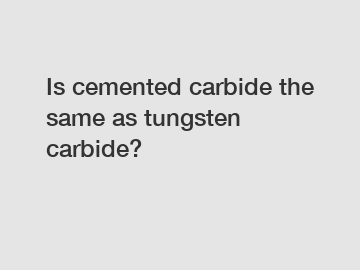Mar. 16, 2024
Minerals
Cemented Carbide vs. Tungsten Carbide: Are They the Same?
Cemented carbide and tungsten carbide are two terms that are often used interchangeably in the manufacturing industry. However, there are subtle differences between the two that are important to understand, especially when choosing the right material for a specific application. In this article, we will explore the differences between cemented carbide and tungsten carbide and clarify whether they are the same or not.
What is Tungsten Carbide?

Tungsten carbide is a compound made up of tungsten and carbon atoms in equal parts. It is an incredibly hard material that is used in a wide range of industrial applications, from cutting tools and drill bits to mining and construction equipment. Tungsten carbide is known for its high hardness, wear resistance, and strength, making it an ideal choice for demanding applications where other materials would quickly wear out.
What is Cemented Carbide?
Cemented carbide, on the other hand, is a composite material made up of tungsten carbide particles (or other carbides) held together by a binder metal, typically cobalt. The binder metal acts as a glue that holds the carbide particles together, forming a tough and wear-resistant material that is widely used in cutting and forming tools, wear parts, and other industrial applications. Cemented carbide combines the hardness and wear resistance of tungsten carbide with the toughness and ductility of the binder metal, resulting in a material that offers the best of both worlds.
Differences Between Cemented Carbide and Tungsten Carbide.
While tungsten carbide is technically a pure compound of tungsten and carbon, cemented carbide is a composite material that contains tungsten carbide particles along with a binder metal. This means that while tungsten carbide is a single-phase material, cemented carbide is a two-phase material that consists of both carbide particles and binder metal.
Another key difference between the two materials is their properties. Tungsten carbide is extremely hard and wear-resistant, but it can also be brittle and prone to chipping or cracking under certain conditions. Cemented carbide, on the other hand, is tougher and more ductile thanks to the binder metal, making it less prone to fracture and more suitable for applications where impact resistance is required.
Which One Should You Choose?
When deciding between cemented carbide and tungsten carbide for a specific application, it is important to consider the requirements of the job at hand. If you need a material that is extremely hard and wear-resistant, tungsten carbide may be the best choice. However, if you also need a material that is tough and impact-resistant, cemented carbide would be a better option. In many cases, cemented carbide is preferred over tungsten carbide due to its superior toughness and ductility.
In conclusion, while cemented carbide and tungsten carbide are related materials, they are not the same. Tungsten carbide is a pure compound of tungsten and carbon, while cemented carbide is a composite material that contains tungsten carbide particles and a binder metal. Understanding the differences between these two materials is essential for choosing the right material for a specific application.
Contact us.
If you have any questions about cemented carbide or tungsten carbide or need assistance in choosing the right material for your application, please do not hesitate to contact us. Our team of experts is here to help you find the best solution for your needs.
The company is the world’s best unground carbide rods, Carbide Mining Tools Manufacturer, tungsten carbide dth drill bit supplier. We are your one-stop shop for all needs. Our staff are highly-specialized and will help you find the product you need.
Previous: Is the LNG pipeline endangering indigenous communities?
Next: Button magnet in precast concrete: How to choose the best option for your purchase?
If you are interested in sending in a Guest Blogger Submission,welcome to write for us!
All Comments ( 0 )